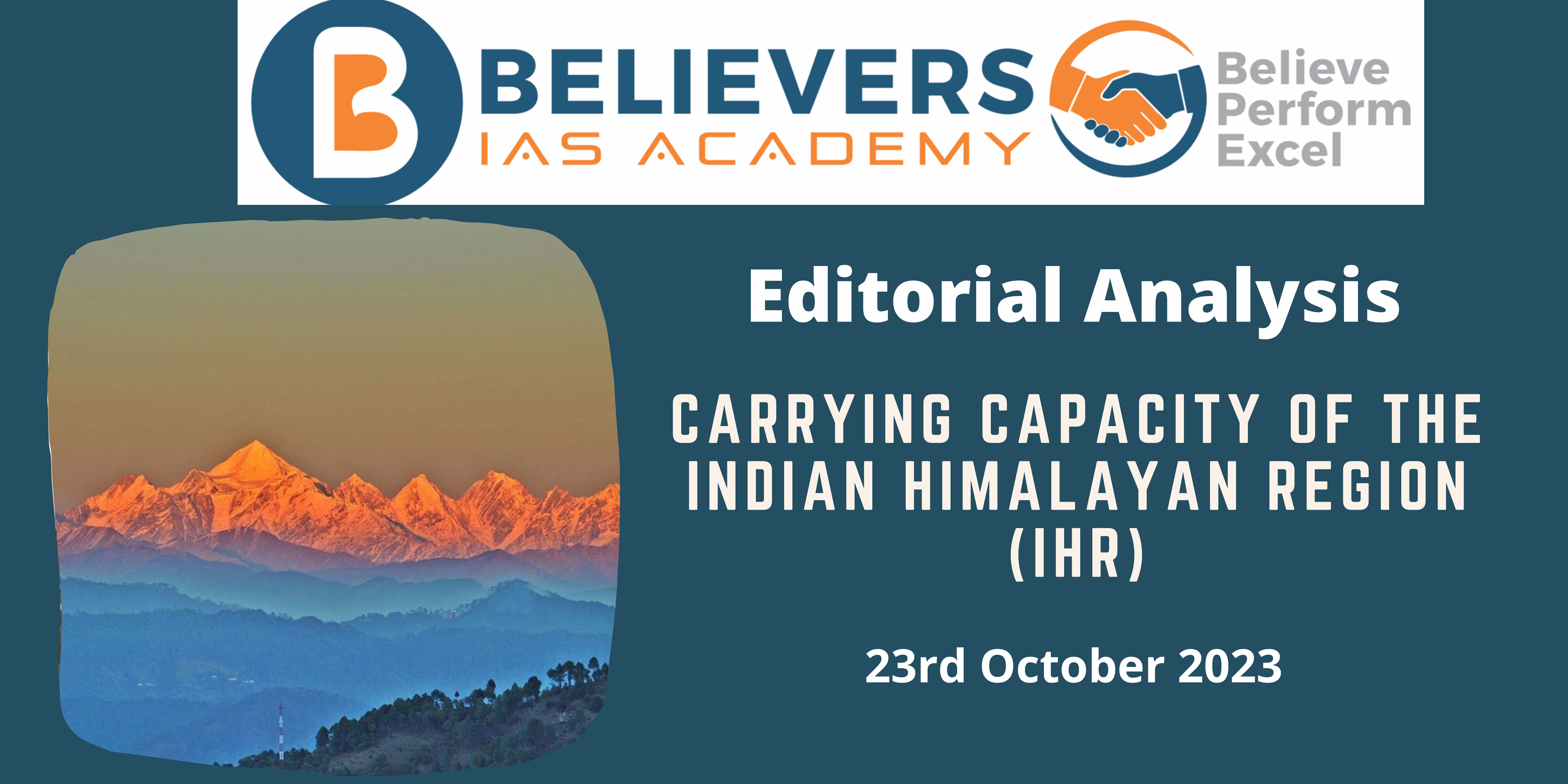Carrying Capacity of the Indian Himalayan Region (IHR)
Context:
Recently, the Supreme Court of India has asked the Union government to provide insights into managing the carrying capacity of the Indian Himalayan Region (IHR) for towns and cities after the environmental damages that happened in Himachal Pradesh, Uttarakhand, and Sikkim.
Relevance:
GS-03, GS-01 (Conservation, Geographical phenomena)
Prelims:
Indian Himalayan Region, Microclimate, National Mission on Sustaining Himalayan Ecosystem, Glacial-lake outburst floods, Uttarakhand Flood 2013.
Mains Question:
Explain “carrying capacity” for a region, and how can it be effectively assessed and managed in the Indian Himalayan Region (IHR)? (150 words, 10 marks)
Dimensions of the Article:
- Carrying Capacity
- Government Initiatives in the IHR
- Challenges in Progress
- The Expert Committee
Carrying Capacity:
- The carrying capacity for a region signifies the maximum population size that an ecosystem or environment can support sustainably over a specific period without causing significant harm to its natural resources and overall health.
- It is useful for the balance between human activities and the preservation of natural ecosystems, ensuring long-term sustainability.
Government Initiatives in the IHR:
- Over the period, the government has launched various initiatives for the development of the IHR like –
- National Mission for Sustaining the Himalayan Ecosystem (2010)
- Indian Himalayas Climate Adaptation Programme
- Secure Himalaya Project
- Recently guidelines on ‘Carrying Capacity in the IHR’ issued on January 30, 2020.
- On May 19, 2023, the Ministry of Environment and Forests sent out a reminder to all states to submit an action plan on carrying capacity if it had not been done already.
Challenges in Progress:
- Despite these initiatives, the progress hasn’t been satisfying and the reasons for this stagnation can be attributed to two major factors.
A) The composition of groups created by the Ministry for addressing these issues has been flawed. The same individuals responsible for the environmental issues in the region are now tasked with finding solutions.
B) The focus should shift towards people-centric sustainable development.
- While it is relevant to include the entire IHR, focusing solely on towns and cities’ carrying capacity is insufficient. For instance, the road network in Himalayan States has led to unplanned settlements. Therefore, the top court should concentrate on the “Sustainable Population” of the Himalayan States, considering the carrying capacity for the sustainable populations of different Himalayan States.
- There is a long-term necessity for evaluating the overall sustainable capacity of the environment within the entire state, including all biological species, food, habitat, water resources, ecology, and agriculture.
The Expert Committee:
- The expert committee should address the social aspects and population sustainability of each state. And the expert committee should not be a bureaucratic or technical group. It should include significant citizen representation, involving panchayats and other urban local bodies.
- Given the importance of the resident population living in towns and villages within the IHR
- The expert committee should instruct each panchayat samiti and municipality to provide recommendations in response to the established population sustainability criteria. These recommendations should be disseminated to each local government center.
- It is crucial to acknowledge the concerns of the local populace regarding the construction of hydropower projects and four-lane highways in the IHR. Neglecting these concerns, particularly in the case of Sikkim, has resulted in adverse consequences. Collaborating with the people is essential to build sustainable solutions.
Way Forward:
Addressing the carrying capacity in the Indian Himalayan Region requires a comprehensive and people-oriented approach. The government’s recommendation focuses heavily on one institution, the G.B. Pant National Institute of Himalayan Environment, with other institutes playing more minor roles. These institutes are significant players in their respective domains and should have equal say in policy formulation.




